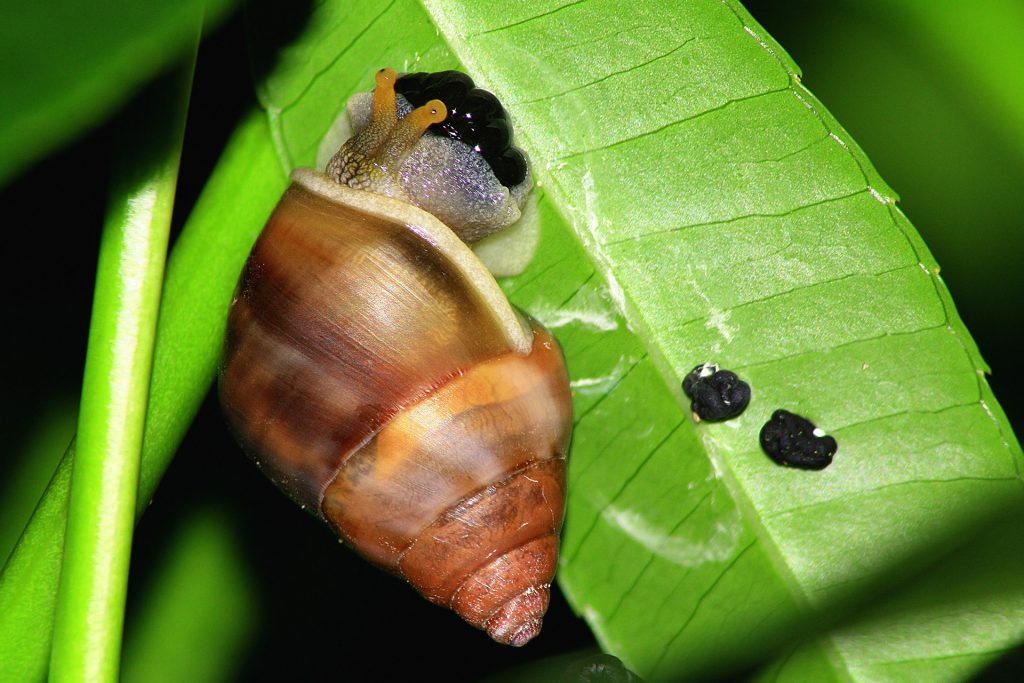Slugs and snails look harmless but they can wreak havoc on the plants in your garden. They chew through leaves, eat seedlings, and they can devastate fruit and vegetable patches. What’s more, because they are molluscs, they are mostly resistant to regular garden insecticides. However, there are some methods that you can use to greatly reduce the threat they pose to the garden, although you will never completely eradicate them.
Gastropods are the second largest animal class in the United Kingdom, with only insects more prevalent. They are so common, in fact, that a square metre of garden is believed to contain 200 slugs, and only 5% of the slug population of a garden is found on the surface; the rest are underground, eating seedlings, laying eggs, and generally destroying your garden.
They are hermaphrodite, which means that they have both male and female reproductive organs. They can reproduce by themselves, although they do prefer to reproduce with a partner. Evolutionarily speaking, slugs originate from the sea, and this is why they need moisture to survive.
In This Guide
Good Garden Care
General garden care can help alleviate the problem. Both pests like damp and dark environments to rest in, especially during the day when they are inactive. They find wet, fallen leaves, especially inviting, so clearing up leaves, removing empty pots, and moving damp wood away from the garden and off the patio (they will congregate around paddling pools and patio heaters as the condensation is ideal for them) – will make the environment less hospitable and prevent some of the slugs from staying on your property. Dead heading and removing damaged leaves, especially around floor level, means that these areas will be better aired, which can also help make your garden a less hospitable and inviting area.
Because gastropods like a damp environment, and are active at night, you should avoid watering the garden too close to the evening time. Water in the morning; this allows the soil to dry throughout the day and before night time.
You can also purchase an array of traps to catch the little critters!





Choose The Right Plants
Anybody that has tried growing lettuce, or certain strands of Hosta, will know that they have a preference for certain types of plant. Generally, they prefer plants with thin and delicate leaves. This is why lettuce is such an attractive proposition for them. And, while it is true that some Hostas act as a magnet to slugs and snails, there are some variants that are more resistant than others. Blue Ivy, for example, has thick and waxy leaves, and slugs are unable to efficiently chew through.
Getting Rid Of Eggs
Snails and slugs lay eggs in the same places that they hide during the day. They lay eggs on damp and moist surfaces, and while these can be difficult to identify, you can lay traps to accumulate the eggs before disposing of them. For example, place damp wood near the plants, wait until you have a sizeable number of eggs, and then dispose of them. Alternatively, you can collect the eggs and then sprinkle salt or ammonia on them.

Slug eggs look a little like frogspawn, although they can also be a milky white colour. They are small, but there can be as many as 50 in a single batch. They are commonly found in compost bins and under plant pots; anywhere that you might find slugs during a dry spell. Although it is more likely that the eggs are laid during summer, slugs do lay eggs throughout the year including winter.
Create A Physical Barrier
Slugs do not like crawling over rough surfaces. Some people place eggshells or gravel, while others use copper (although results have proven mixed, using copper tape), and place these around the base of plants. However, not everybody wants ground up egg shells in their garden.
Salt is a commonly used means of killing slugs, and it definitely works. However, salt will also kill plants, some insects, and it will leave an orange sticky mess. For many people, it can also seem cruel to get rid of slugs in this way.
Attracting Natural Predators
Believe it or not, slugs and snails both have natural predators. A lot of birds, as well as frogs and toads, turtles, and ducks will eat these pests and help keep your garden clear, but not all gardens are home to these natural predators. Even some beetles are natural predators of these spineless garden visitors.
The key to attracting these natural predators is to provide them with a natural environment. The predators you are attempting to attract are indigenous to your garden, which means that they will feed on and use indigenous plants. Use indigenous plants, trees, and shrubs, to create a natural garden, or a natural section of the garden, and leave this area alone.

Offering a garden pond will also help attract a lot of birds, because they feed on the algae and insects around the pond and they drink and use the water itself. Offer piles of leave in quiet spots – these will attract hedgehogs, which are another great predator that will happily help you control slug and snail numbers.
As well as plants, you can add cairns, which are piles of stones, which some of the predators will use as shelter and for nesting. An alternative to this is to create a dry stone wall or other dry stone structure.
Pesticides – Yea or Nay?
Pesticides and insecticides will have very little, if any, effect on gastropods. They are molluscs, and so the ingredients found in these products are not designed to deter or kill them. What’s more, the pesticides you put down could kill of predators that you are trying to attract.
Even pesticides labelled as “harmless” are likely to cause damage to some insects and other species in the garden. Rather than helping to control slugs, killing their predators will actually only serve to heighten the problem, rather than improve it. There are natural slug traps that don’t utilise pesticides.
Use a Natural Slug Repellent
Using a natural slug repellent can be more friendly to the environment and some will leave your conscience clear! Try the following to keep slugs away or at bay.
- Cornmeal
- Seaweed
- Sand / Wood Chips / Gravel or any other sharp ground will keep the slugs away as it’s too rough for them
- Slugs don’t like any of the following flowers: Rosemary, Sage, Mint, Pumpkins, Ginger, Garlic, Fennel, Basil, Chicory, Daffodils, Endive
- Pine Needles
- Citrus Rinds
- Bran instead of Salt – if you’re a keen gardener, you’ll know that salt ruins the soil. Use bran instead and it dries slugs and snails out.
Or use any one of these purchasable natural slug repellents.
How to Get Rid of Slugs in the House
Slugs aren’t necessarily just a problem outside the property either. They can find their way into your house and are often found in the kitchen where they are attracted to food debris and other waste. This is less of a problem with snails because of the shell, but a slug can stretch itself out to 20 times its normal body length, allowing it to squeeze through incredibly tight and small spaces.
The kitchen is a popular spot for slugs and snails. Even the most careful home cook tends to drop some debris on the floor, and gastropods will greedily snap this up. If you have cats or dogs and put food down for them overnight, this is another common attraction. If you can stop leaving pet food down at night, this could help deter these pests from the kitchen.
Putting food on the worktop is not a good idea. Not only does this mean having cat food and cats on surfaces where you prepare food, but slugs can scale vertical surfaces and they can even move upside down. You could be attracting them onto the work surfaces.
You can put salt down in areas where slugs congregate and eat. However, it is prudent to prevent the invertebrates from getting in in the first place. Follow slug trails back to their point of origin. You can use a torch or flashlight to help you spot and follow the trails. Look for holes in the wall, holes around pipes, and other potential gaps. Remember that slugs can get in through very small gaps, so don’t just look for large holes.
Filling The Gaps
It should be quite easy to fill a lot of these gaps – use a silicone sealant for smaller gaps, and an expanding foam for larger gaps.

If there are a lot of large gaps, or gaps that are too large to reasonably deal with by using sealants, you might want to contact your landlord or property management company and have them come and check to see what can be done. It is unlikely that a slug problem in the kitchen is the responsibility of your landlord, but gaps, cracks, and holes in the wall and around pipes, could be their responsibility, and sealing them will not only help combat a problem with gastropods but could minimise draughts and cold and even help prevent mould and other problems.
Large gaps under doors also act as a doorway for slugs. Obviously you can’t seal these gaps with sealant and filler. Door seals can be fitted, although if it’s a back door or front door, you should consider getting these replaced to ensure that they are secure, and to make sure that they are not allowing wind and cold to get into the property, as well as slugs.
Getting Rid Of Your Slug Problem
Slugs and snails do serve a useful ecological purpose. Outside the garden they consume rotting organic matter and leave natural fertiliser behind. However, in the garden they are considered a pest and a nuisance, and using a single method to get rid of them is unlikely to yield the results that you are looking for.
Employ different techniques to make your garden an uninviting prospect for these pests, utilise the methods above, and minimise the number of cracks and holes that they can use to get inside the house, and you will see a marked reduction in the number of slugs you find. Remember, however, that you will never be able to completely eradicate the problem, only control the numbers.
Last update on 2024-04-27 / Affiliate links / Images from Amazon Product Advertising API






